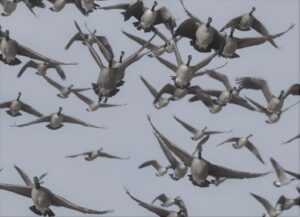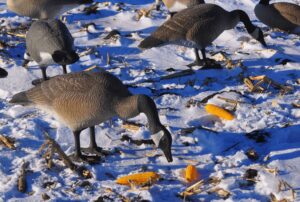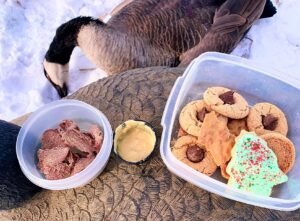Photography courtesy of Lowell Washburn, all rights reserved.
Iowa goose hunters are feeling a bit down this week. As of sunset January 22, hunting seasons are now closed in all of the state’s three-tiered goose zones. This year’s goose chase is over. Time to clean the shotguns, stow the decoys and begin dreaming of next season.
For Canada goose enthusiasts, there is good reason to lament the season closure. There is just something about goose hunting, something so special, that it eclipses all other forms of waterfowling. When an approaching squadron of geese simultaneously lock their wings and began the descent to your decoys, it builds an anticipation that brings – well, brings shivering goose bumps waiting hunters.

And let’s not forget the sounds that accompany goose hunting. The clamorous baritone honking of wild geese is a siren song that cannot be denied. It’s a winsome symphony so compelling that it causes normally sane people to suddenly find themselves dressed in whites, surrounded by dozens of decoys and laying in a snow-covered cornfield on a day when January wind chills have plummeted to ten, twenty, or even thirty below zero – all in the hopes that the same geese that snubbed their decoys yesterday will somehow succumb to the ruse when they fly to feed today.
Iowa’s goose hunting craze is clearly contagious. As Canada goose populations have soared, the popularity of hunting the birds has soared as well. But although goose numbers are impressive, bringing a plump honker to bag remains a challenge. Hunting seasons begin in September, and it doesn’t take long for today’s highly pressured geese to smarten up. As early season flocks bounce back and forth between decoy spreads, all the easy birds are quickly eliminated. By late October, most street wise flocks have relocated to the safety of wildlife refuges or moved to the city limit sanctuaries provided within urban landscapes. Despite making daily excursions to harvested feeding fields, these highly educated fowl become nearly impossible to kill. Even the large spread crews who fancy themselves as expert pro-staffers are likely to go home empty handed.

By Thanksgiving, most goose hunters have packed it in for the year. But for those willing to stick with it, there is still hope for improved success. That hope arrives in the form of snow cover. No matter how smart an individual goose has become, snow cover will effectively reduce its IQ by at least 50 percent, a fact which lowers the bird’s mental acuity to roughly the same level as those hunters who lay waiting in the frozen cornstalks.
With ready access to limitless supplies of waste grain, Canada geese become so hog fat that you can barely locate their gizzards. Fat geese can afford to cautious in everything they do. But cover local feeding fields with four or five inches of new snow, and those same overweight honkers will think they’re about to starve. As temperatures drop, anxiety escalates. Obsessed with locating a square meal, incoming flocks will once again believe that your plastic decoys are real live geese and that they are enjoying a double helping of corn on the cob.

Although snow cover does not guarantee that everyone will shoot limits of geese every time they take to the field, it does mean that hunters will be bringing home more birds than they did before the white stuff arrived. It should also be noted that although January goose hunts offer a potential for increased success, the outings are never easy. Environmental conditions are brutal. Frostbite can be a real possibility and you need to dress for the occasion. In Iowa’s North Zone, my coldest hunt of the season occurred in early January when wind chill values plunged to a bone numbing minus 38-degrees. Goose season or not, that’s a cold day to lay in a cornfield.
But the misery level wasn’t quite as bad as you might think. While waiting for geese to come off refuge airholes, we remained well fortified with life sustaining provisions that included piping hot Black Rifle Chainsaw Grind coffee, leftover Christmas cookies, and homemade peanut brittle. My friend and fellow waterfowling enthusiast, Al Hancock provided a sandhill crane that he’d bagged in North Dakota. Commonly referred to as ‘ribeye of the sky’, we sliced the bird thin and paired it with Dijon mustard. The crane easily lived up to the species’ reputation. To describe the in-the-field taste treat as out of this world would be to grossly understate its incredible flavor.

On some days the cold, foot stomping waits seemed endless. But sooner or later, the geese would begin to fly. Once the feeding flights began, they were remarkably spectacular — line after line of honking geese in nonstop progressions lasting for an hour or more.
A simple white outfit is my favorite winter camouflage. The camo is effective enough that I recently had one noisy Canada almost land atop my motionless form. When I sat up to look the goose in the eye, the bird almost seemed embarrassed. Taking a step sideways, the alarmed honker stretched his black neck and prepared to leap back into the sky. But when the rest of the geese – my decoys – remained calm, the gander changed his mind and decided to stay for a snack. I don’t know what in the world that big bird thought I was, but it was a memorable occasion to say the least. Those are the kind of close encounter events that keep me squeezing into virtually every cold weather garment I own and returning January’s snow-covered goose fields. When it comes to Canada geese, you just never know what the day will bring.


 Susan Judkins Josten
Susan Judkins Josten Rudi Roeslein
Rudi Roeslein Elyssa McFarland
Elyssa McFarland Mark Langgin
Mark Langgin Adam Janke
Adam Janke Joe Henry
Joe Henry Sue Wilkinson
Sue Wilkinson Tom Cope
Tom Cope Kristin Ashenbrenner
Kristin Ashenbrenner Joe Wilkinson
Joe Wilkinson Dr. Tammy Mildenstein
Dr. Tammy Mildenstein Sean McMahon
Sean McMahon